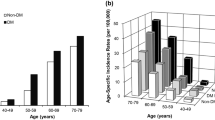Abstract
Background
The risk of pancreatic cancer is elevated among people with new-onset diabetes (NOD). Based on Rochester Epidemiology Project Data, the Enriching New-Onset Diabetes for Pancreatic Cancer (END-PAC) model was developed and validated.
Aims
We validated the END-PAC model in a cohort of patients with NOD using retrospectively collected data from a large integrated health maintenance organization.
Methods
A retrospective cohort of patients between 50 and 84 years of age meeting the criteria for NOD in 2010–2014 was identified. Each patient was assigned a risk score (< 1: low risk; 1–2: intermediate risk; ≥ 3: high risk) based on the values of the predictors specified in the END-PAC model. Patients who developed pancreatic ductal adenocarcinoma (PDAC) within 3 years were identified using the Cancer Registry and California State Death files. Area under the curve (AUC), sensitivity, specificity, positive predictive value (PPV), and negative predictive value (NPV) were estimated.
Results
Out of the 13,947 NOD patients who were assigned a risk score, 99 developed PDAC in 3 years (0.7%). Of the 3038 patients who had a high risk, 62 (2.0%) developed PDAC in 3 years. The risk increased to 3.0% in white patients with a high risk. The AUC was 0.75. At the 3+ threshold, the sensitivity, specificity, PPV, and NPV were 62.6%, 78.5%, 2.0%, and 99.7%, respectively.
Conclusions
It is critical that prediction models are validated before they are implemented in various populations and clinical settings. More efforts are needed to develop screening strategies most appropriate for patients with NOD in real-world settings.


Similar content being viewed by others
Abbreviations
- CI:
-
Confidence interval
- NOD:
-
New-onset diabetes
- END-PAC:
-
Enriching New-Onset Diabetes for Pancreatic Cancer
- PDAC:
-
Pancreatic ductal adenocarcinoma
- KPSC:
-
Kaiser Permanente Southern California
- SEER:
-
Surveillance, Epidemiology, and End Results
- ICD-9-CM:
-
Ninth Revision of International Classification of Diseases, Clinical Modification
- ICD-10-CM:
-
Tenth Revision of International Classification of Diseases, Clinical Modification
- AUC:
-
Area under the curve
- PPV:
-
Positive predictive value
- NPV:
-
Negative predictive value
References
Rawla P, Sunkara T, Gaduputi V. Epidemiology of pancreatic cancer: global trends, etiology and risk factors. World J Oncol. 2019;10:10–27.
US Preventive Services Task Force Website: https://www.uspreventiveservicestaskforce.org/Page/Document/RecommendationStatementFinal/pancreatic-cancer-screening1. Last Accessed on 10/08/2019.
He XY, Yuan YZ. Advances in pancreatic cancer research: moving towards early detection. World J Gastroenterol. 2014;20:11241–11248.
Singhi AD, Koay EJ, Chari ST, Maitra A. Early detection of pancreatic cancer: opportunities and challenges. Gastroenterology. 2017;156:2024–2040.
Chari ST, Leibson CL, Rabe KG, Ransom J, de Andrade M, Petersen GM. Probability of pancreatic cancer following diabetes: a population-based study. Gastroenterology. 2005;129:504–511.
Munigala S, Singh A, Gelrud A, Agarwal B. Predictors for pancreatic cancer diagnosis following new-onset diabetes mellitus. Clin Transl Gastroenterol. 2015;6:e118.
Pannala R, Basu A, Petersen GM, Chari ST. New-onset diabetes: a potential clue to the early diagnosis of pancreatic cancer. Lancet Oncol. 2009;10:88–95.
Boursi B, Finkelman B, Giantonio BJ, et al. A clinical prediction model to assess risk for pancreatic cancer among patients with new-onset diabetes. Gastroenterology. 2017;152:840–850.
Sharma A, Kandlakunta H, Nagpal SJS, et al. Model to determine risk of pancreatic cancer in patients with new-onset diabetes. Gastroenterology. 2018;155:730–739.
Chari ST, Leibson CL, Rabe KG, et al. Pancreatic cancer-associated diabetes mellitus: prevalence and temporal association with diagnosis of cancer. Gastroenterology. 2008;134:95–101.
Poruk KE, Firpo MA, Adler DG, Mulvihill SJ. Screening for pancreatic cancer: why, how, and who? Ann Surg. 2013;257:17–26.
Koebnick C, Langer-Gould AM, Gould MK, et al. Sociodemographic characteristics of members of a large, integrated health care system: comparison with US Census Bureau data. Perm J. 2012;16:37–41.
Chen W, Yao J, Liang Z, et al. Temporal trends in mortality rates among Kaiser Permanente Southern California Health Plan enrollees, 2001–2016. Perm J. 2019;23:18–213.
American Diabetes Association. Diagnosis and classification of diabetes mellitus. Diabetes Care. 2010;33:S62–S69.
International Expert Committee International Expert Committee report on the role of the A1C assay in the diagnosis of diabetes. Diabetes Care. 2009;32:1327–1334.
O’Brien DP, Sandanayake NS, Jenkinson C, et al. Serum CA19-9 is significantly upregulated up to 2 years before diagnosis with pancreatic cancer: implications for early disease detection. Clin Cancer Res. 2015;21:622–631.
Bleeker S, Moll H, Steyerberg E, et al. External validation is necessary in prediction research: a clinical example. J Clin Epidemiol. 2003;56:826–832.
Funding
Research reported in this publication was supported by the American Pancreatic Association. The content is solely the responsibility of the authors and does not necessarily represent the official views of the American Pancreatic Association.
Author information
Authors and Affiliations
Contributions
W.C led the study design/data interpretation/manuscript preparation and obtained funding. R.K.B conducted data analyses and participated in the study design/data interpretation/manuscript preparation. E.L participated in the study design/data interpretation. S.T.C provided detailed information regarding the END-PAC model to help the design and the interpretation of the current study. B.U.W participated in the study design/data interpretation/manuscript preparation and provided clinical guidance. All the authors reviewed and approved the manuscript.
Corresponding author
Ethics declarations
Conflict of interest
The authors declare they have not conflict of interest for this study.
Additional information
Publisher's Note
Springer Nature remains neutral with regard to jurisdictional claims in published maps and institutional affiliations.
Appendices
Appendix 1
See Table 5.
Appendix 2: ICD-O-3 Histology Codes Used to Identify Pancreatic Ductal Adenocarcinoma (PDAC)
Please refer to the Web site for information on the histology codes.
https://www.naaccr.org/wp-content/uploads/2018/01/Updated-Jan-10-2018-ICD-O-3-Guidelines-v2.pdf.
8000 |
8001 |
8010 |
8020 |
8021 |
8022 |
8140 |
8141 |
8143 |
8210 |
8211 |
8230 |
8255 |
8500 |
8501 |
8503 |
8504 |
8507 |
8508 |
8521 |
8552 |
8560 |
8570 |
8571 |
8572 |
8573 |
8574 |
8575 |
8576 |
Rights and permissions
About this article
Cite this article
Chen, W., Butler, R.K., Lustigova, E. et al. Validation of the Enriching New-Onset Diabetes for Pancreatic Cancer Model in a Diverse and Integrated Healthcare Setting. Dig Dis Sci 66, 78–87 (2021). https://doi.org/10.1007/s10620-020-06139-z
Received:
Accepted:
Published:
Issue Date:
DOI: https://doi.org/10.1007/s10620-020-06139-z




